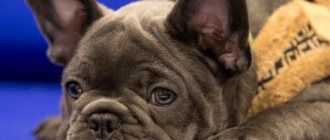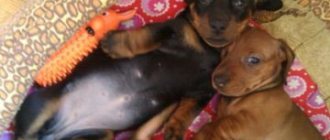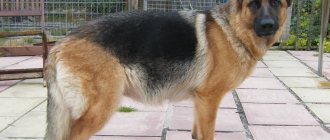Dachshund is one of the most popular and widespread breeds.
She is loved by both hunters and ordinary dog breeders.
These are loyal, active, cheerful pets with a light character and a loud bark.
Sometimes dachshunds bark so loudly that they drown out even the largest dogs.
They easily learn commands, understand their owner and interact well with other animals and children.
How to choose a pair?
Before you start choosing a “groom” for your girl, you should critically and carefully evaluate her advantages and disadvantages . After all, owners of male dogs are usually very picky about the choice of a bitch.
Also, an important role in the selection of a partner is played by the dog’s exterior and character matching.
But, you should remember that the chosen male should not be inferior to your bitch in any respect, since puppies from an ordinary manufacturer are not popular and will be difficult to place.
What qualities of a male dog should you pay attention to?:
- Health.
- Mental stability.
- Compliance with the breed.
- Age.
When Your Dog May Need Help
Not in every case the woman giving birth needs your help. Of course, it’s good if you help clean the babies from blood and mucus, but a healthy animal can handle this quite well. The only exception can be when the female gives birth for the first time.
Don't let your guard down. At any moment, the bitch may develop complications, and then only you can take control of the situation. For example, when your pet’s water breaks but contractions have not started, she needs to be given oxytocin. It stimulates the uterus, and it begins to contract normally. You cannot give such injections on your own - first call your veterinarian and get a consultation. He will assess the situation and recommend a dosage.
You should urgently call a veterinarian if bleeding begins - this can be understood by the scarlet, increasing discharge from the vulva. Green-brown discharge should also alert you if the puppies are delayed in appearing.
If the female ignores the umbilical cord and bladder of the newborn, your task is to deal with them yourself. In a stressful situation, the dog is simply confused and does not know what to do. Every second counts: you need to cut the umbilical cord using scissors with round edges, having previously disinfected them.
If, after the bubble has been removed, the baby still does not begin to breathe, use suction and remove all mucus and fluid from the respiratory tract. Be careful not to injure him - babies are very fragile in the first few days of life.
The bitch may be too tired to attend to her children's hygiene. Then you will have to take care of this. Soak a towel in warm water and dry all newborns thoroughly. There should be no mucus or bubble residue left on them.
After all have been born, licked by the mother, or washed by you, place them next to the bitch's nipples. After birth, they need to eat and gain strength.
Basic rules step by step
- About a month and a half before the heat, give your pet a comprehensive test for infections (staphylococcus, streptococcus, herpes virus, etc.).
- A month before the start of heat, treat your dog with medications against ticks, fleas, lice and other parasites. And after another week, give her an anthelmintic.
- 12-15 days after the start of estrus, the bitch is ready for mating and can be taken to the “groom”.
- Plan the mating for the morning, do not feed the dog beforehand and let him take a short walk.
- The place for mating is prepared in advance, and the “bride” is always taken to the “groom” so that the male feels confident.
- When introducing pets, owners should be careful. If the male is inexperienced, he may mount incorrectly, be overly excited or aggressive. The same goes for the bitch. If the pets do not find a common language, you will have to resort to the help of a specialist, and on this day the mating may have to be postponed.
- When the “bride” is ready, she takes a stance and moves her tail back. The owner should sit down in front of her and hold her firmly by the collar. In this case, the owner of the dog sits down on the side, holds his pet by the stomach and carefully directs the bitch’s loop to the male’s genitals. At this time, the male makes preliminary mountings (jumps on his partner, clasps her with his front paws, looks for the entrance to the vagina). The purpose of such cages is to find a comfortable position.
- As soon as the optimal position is found, the male inserts the genital organ into the bitch’s vagina and begins to make thrusts, gradually increasing their strength. As soon as the tremors become weaker and their number increases, you know that ejaculation occurs. After ejaculation is complete, the male falls exhausted onto his partner’s back.
- During sexual intercourse in dogs, a so-called lashing occurs. In this case, the loop tightly covers the penis and the male cannot leave the bitch before the muscles of her vagina weaken. Dog owners simply need to know this and under no circumstances “take away” their animals by force! The duration of cutting is from 15 minutes to 1 hour.
Expert opinion
Kozhevin Semyon Kirillovich
Expert dog handler.
“As an experienced breeder, I would recommend doing another control 2-3 times after mating. This is especially true for owners of show dogs who are planning appropriate offspring. Do not use force during mating under any circumstances. And if you are not experienced, use the services of an instructor.”
Preliminary preparation for mating
The first thing to do is to choose a pair for the bitch. The male must correspond to the breed standard and exterior, the characters of the dogs must fully correspond. The male in question should not be inferior to your girl in any respect, because puppies from a simple manufacturer are not at all wildly popular among buyers and breeders. Check to see if the male is physically and mentally healthy and suitable in age.
It is important to prepare for pregnancy 1 – 1.5 months before the expected estrus. Take your dog to a veterinary clinic, conduct a comprehensive examination, and check for infectious diseases (streptococcus, staphylococcus, herpes, etc.). It is important to treat against ticks and worms, lice, and fleas. After a week, worm the animal. After the onset of estrus, your pet is ready for mating already on the 12th – 15th day. It is recommended to plan mating for the first half of the day, preferably in the morning.
When the “bride” meets the “groom”, be careful: an inexperienced male may well make mistakes, show excessive aggression or agitation. If the animals do not find a common language, postpone mating and show them to a specialist.
Subtleties you need to know about
How can you determine a dachshund’s readiness to mate with males:
- she pulls her tail back;
- flirts with “men”;
- reacts sharply to stroking the back, raising the tail;
- light discharge appears.
If, after the appearance of all these key points, mating is carried out immediately, the desired pregnancy may not occur at all. If the opposite happens and it occurs, there will be very few puppies in the litter. There are certain deviations from the norm that prevent a dog from giving birth to healthy offspring:
- very light, almost invisible discharge;
- throughout all days of the cycle, discharge is scanty;
- the dog “loop” is very rigid and of the usual size;
- The female behaves aggressively towards dogs of the opposite sex and does not allow anyone to approach her.
To quickly secure a “marriage” between two animals, just watch how your dog is in heat. It is the individual characteristics and characteristics that will help you accurately determine the time for mating. For dachshunds that are not yet a year old, mating is contraindicated for many reasons:
- the “bride” is not yet mature at all and is not psychologically ready for a confrontation;
- the dachshund has not gained the necessary body weight that will help her bear puppies;
- the body of a “young” dachshund is not yet fully formed, only a mature dog is able to bear offspring for the entire term without problems;
- at this age there is a risk of having underdeveloped or very weak babies;
- childbirth occurs with serious complications and leads to health problems.
If a small, immature pet becomes pregnant, her metabolism (metabolism) is disrupted, and due to feeding, a lot of vital calcium is removed from the body. To accurately determine the favorable period for crossing, you can contact your veterinarian at the clinic. In the laboratory, material is taken for a smear, which will help to find out the stage of the cycle.
Dogs also have their own menstrual cycle, consisting of 4 stages:
- Proestrus is a period that lasts approximately 9-10 days. The dog's appetite and behavior change dramatically; the dog may not eat at all or eat everything in its path. The vulva begins to swell and a small reddish discharge begins to appear. At this stage, the bitch is not yet ready for mating.
- Estrus - lasts 2 weeks, discharge is yellowish or brownish, but there is less of it. The swelling of the vulva subsides, while touching itself, the dog raises its pelvis and moves its tail slightly to the side.
- Metatrus – lasts from 2 months to 150 days. The dachshund has noticeable changes in behavior and the swelling of the vulva has almost subsided. Males are now completely uninterested in the animal.
- Anestrus - the dog completely calms down, ovarian activity decreases.
It is important to know how to properly prepare a male dog for mating. Boys can be bred from 12 to 15 months, and in order for the male to feel good, 3–4 matings are arranged per year. If the male is not untied, he normally tolerates the company of females, which cannot be said about a sexually mature and untied male. As a rule, the process takes place on the territory of the male dog - he feels much more confident and calm in his area. There is no need to create special conditions for pets. However, if at least one part of the couple shows anxiety, uncertainty or gives in, it is important to save a favorite toy or treat for such a moment.
How can you tell if your dog is pregnant?
In the first month of pregnancy, this can only be done based on indirect signs; some dogs’ character changes, they become more affectionate, and their food preferences may also change.
Sometimes during pregnancy a dachshund experiences toxicosis; she may refuse her favorite food and generally lose her appetite..
Starting from the fourth week, the dog’s nipples become larger and the tummy becomes rounder.
Symptoms of estrus and pet behavior characteristics
Each stage of estrus has its own symptoms. Shortly before an imminent heat, the following signs begin to appear:
- There are changes in the dog's behavior. The dachshund can become aggressive or, on the contrary, too affectionate.
- Food preferences change. The pet may refuse a portion or persistently ask for more.
- The vulva is swollen.
Next comes blood. At first there is little discharge, but every day the amount of blood increases. The dog tucks its tail, especially if other dogs are walking nearby.
After some time, the discharge becomes less, the color of the blood changes to brown. The swelling of the vulva subsides and it becomes softer. These days the dachshund pays attention to the opposite sex.
During this period, the bitch does not protect her vulva, but, on the contrary, shows with her entire appearance her readiness for mating.
At the end of the period, the symptoms change again. The dachshund stops flirting with dogs. The vulva is completely restored. The discharge disappears or becomes scanty and transparent.
Important! You can protect your home from dachshund heat with the help of special panties. They absorb waste, leaving furniture and flooring clean.
How is pregnancy going?
| Day after mating | What happens in a dog's body |
| 1-4 | Fertilization occurs immediately after mating or 2-4 days later. |
| 5-11 | The eggs descend into the uterus. |
| 12-14 | The embryos attach to the walls of the uterus. |
| 15 | The vital organs of future puppies are formed. |
| 16 | The size of the embryos is 1 mm. |
| 17 | The head, torso, spinal column and central nervous system develop. |
| 18-19 | Internal organs are formed, the volume of embryos is 4 mm |
| 20-21 | The placenta is formed, the volume of the embryos is 5 mm. |
| 22-24 | The formation of the liver, jaw, organs of vision and hearing occurs. The size of the embryo is 1 cm. |
| 25-29 | Teeth and limbs are formed, the size of the embryo is 1.4-1.7 cm |
| 30 | The volume of the embryo is 2 cm. |
| 31 | The first hairs appear on the embryos. |
| 32-33 | Rapid growth of future babies up to 2.7 cm. |
| 34-35 | The bitch becomes calmer and her appetite increases. |
| 36 | The size of the fruit reaches 3.5 cm. |
| 37-40 | The growth of bones and torso in future babies continues. By day 40, the formation of organs ends. Fruit size – 6.5 cm |
| 41-44 | The offspring in the dog’s stomach can already be felt. |
| 45-47 | The fruit size is 9 cm. |
| 48-49 | There is a significant increase in the abdomen. |
| 50 | The size of the babies is already 12 cm, and movement is visually noticeable. |
| 51 | Colostrum begins to be released from the juices. |
| 52-57 | Fruit size – 15 cm. |
| 58 | The bitch's body is preparing for childbirth. |
| 59-62 | The fruit size is 16 cm, weight 300-600 g. |
| 63-65 | The dog's body is already ready for childbirth, it refuses food, and its body temperature drops. |
Stages of estrus and their duration
The onset of estrus indicates that the dog is becoming sexually mature and can become pregnant. Fertilization is possible only on some days of the estrous cycle.
Let's talk about this in more detail.
The full estrus cycle is approximately 6 months, it is divided into several stages:
- Proestrus. The initial stage at which bloody discharge is observed. The period lasts no more than 9 days. Males show increased interest in the female in heat, but she does not strive to make contact.
- Estrus. The second stage, during which the female can become pregnant, lasts on average 5–7 days, sometimes up to 21. The discharge becomes yellowish, the dachshund, when touched, raises its pelvis and begins to be openly interested in males. The period lasts no more than two weeks.
- Metestrus. The third stage, in which the female does not allow males to approach her. It lasts on average 8 days.
- Anestrus, or diestrus. The fourth stage, during which the activity of the ovaries decreases, the dachshund behaves calmly. The period lasts from 160 to 250 days. The body rests until the next estrus period.
Dog care
In the first half of pregnancy, walk your pet as usual, let her run and play.
This is not contraindicated in the first month. Quite the contrary, the dog must be in good shape in order for the birth to proceed more easily.
Try to arrange a nest for the future family as early as possible . It should be comfortable and warm. There must be access to it in order to provide assistance if necessary.
Also, get the dog accustomed to the nest as early as possible so that it does not look for another place to give birth.
IMPORTANT!
Examine your pet's skin daily; if she has any discharge from the genitals, contact a veterinarian.
Be sure to add vitamins and necessary nutritional supplements to your dog's diet. This will help her bear healthy offspring and give birth to full-fledged puppies.
Why is there no heat
The absence or regular delay of estrus can be due to a number of factors:
- inflammation of the uterus;
- pituitary dysfunction;
- disruption of the ovaries and thyroid gland;
- tumors;
- hormonal disbalance;
- cyst formation;
- congenital and hereditary pathologies.
You won't be able to make a diagnosis yourself. Therefore, a thorough examination at a veterinary clinic is required.
Estrus and pregnancy in Dachshunds are quite easy. You just need to support the dog and help it become a happy mother.
How to understand that labor will begin soon (photo of a pet)
Your pet’s behavior, as well as a number of other signs, will speak volumes about this.
Signs of approaching labor:
- Discharge from the loop.
- Anxious, the dog is actively looking for a place to give birth.
- Discharge of colostrum from the nipples.
- Body temperature decreases.
- Frequent urination, uncharacteristic movements, whining.
Precursors of childbirth in a dachshund girl
Most often, taxi drivers carry pregnancy calmly, without complications. The owner needs to know about the main signs of impending labor in order to prepare in time. The main symptoms of an approaching birth include:
- restless behavior of a pregnant bitch;
- change in appetite;
- sagging of the pregnant belly and hair loss on it;
- the dog asks to go outside and immediately rushes home;
- the dachshunds stop pushing and become quiet in their stomachs;
- The pregnant woman's body temperature drops to 37 ⁰C;
- Gray or white mucus is released from the vagina;
- nipples swell;
- heart rate and breathing increase.
Just before a pregnant bitch begins to give birth, her water breaks. The owner needs to be nearby, especially if it is the first birth.
How is childbirth?
If the dog stops worrying, lies down on the prepared place, its temperature drops, and its abdominal muscles begin to contract, you know that labor has begun. As soon as you notice such signs, do not leave the bitch unattended.
No more than 24 hours should pass between the onset of labor and pushing . If labor has begun but there are no contractions, contact your veterinarian immediately.
Stages of labor:
- Contractions . At this time, the dog’s vaginal muscles relax, the cervix opens, and the uterus begins to gradually contract. During contractions, the abdominal muscles are not used. The duration of contractions is from 6 to 12 hours. At this point, the dog becomes restless, breathes heavily, and looks around. In some cases, vomiting begins.
- Childbirth. The birth process begins after your water breaks, with contractions intensifying and using the abdominal muscles. Then the puppies are born. The frequency of their appearance is from half an hour to three hours.
- Expulsion of the placenta . Usually the placenta will begin to leave the field of birth of each puppy; as a rule, the dog eats it and this is normal. Try to control this process and count how many puppies were born and how many afterbirths came out. If even one remains, it can lead to purulent inflammation of the uterus and serious problems with the dog’s health.
How does a bitch give birth?
If the dachshund stops thrashing around and lies down on a pre-prepared place, the muscles of her pregnant belly are apparently contracting, which means she has begun to give birth. Childbirth includes several stages. The first of these is contractions, during which the vaginal muscles relax, the uterus contracts and its cervix opens slightly. The duration of the stage is from 5 to 12 hours.
The next stage is childbirth. The pregnant woman’s water breaks, the abdominal muscles contract, and baby dachshunds appear through the birth canal at intervals of 0.5-3 hours.
After each baby, the placenta is separated. The process must be controlled so that the afterbirth does not remain inside. The pregnant bitch is trying to eat him. Letting her do this more than twice is unacceptable.
During a normal birth, the dog copes with everything on its own. Newborn dachshunds are freed from the hymen and umbilical cord, wiped with a diaper and applied to the mother's nipple. She licks the dachshunds very actively. This helps to improve their digestion and breathing, and stimulates the production of milk in the bitch herself. The gender and time of birth of each baby is recorded in a notebook. Taxis can be weighed, but if the mother reacts nervously, the procedure should be postponed to a later date. After the birth is over, the whole family is transferred to the den and the dog is given a drink.
What to feed after?
Sample menu for a feeding dachshund:
- Meat.
- Dairy products and milk.
- Offal.
- Fish.
- Vegetables.
- Cereals.
Don't worry if your dog doesn't eat well after giving birth . This usually goes away within 2-3 days.
Feed your dog at 6-8 hour intervals and be sure to let him drink as much as he wants. There must be fresh water near the food bowl.
Also, do not forget about vitamins and nutritional supplements for pregnant and lactating dogs.
Feeding a pregnant dachshund
Throughout pregnancy, the dachshund needs high-quality and nutritious nutrition. In the first half of pregnancy, the feeding regimen and diet do not change. In the second half, the amount of food increases along with the growth of the dachshund's weight.
The total daily food intake increases, but it is important to ensure that the dachshund does not overeat and does not gain weight, this complicates the birth and development of puppies. But under no circumstances should she go hungry. The percentage of protein foods increases: meat, eggs, fish, dairy products. Products high in fiber and starch (porridge, baked goods), on the contrary, are best given in limited quantities. Vegetables are great as fillers and sources of vitamins.
During pregnancy, it is imperative to give the expectant mother vitamins and minerals. A large number of them are needed for the correct and full development of the offspring; their deficiency will especially affect the health of puppies and bitches. You can buy ready-made vitamin-mineral complexes, or calculate the norms together with your veterinarian and add them yourself according to dosage. Particular attention is paid to calcium metabolism. Not only the health of bones and teeth depends on the calcium content, but also the prevention of postpartum eclampsia, which is often found in dachshunds.
At this time, the daily portion should be divided into 2, and from the sixth week into 3 doses.
When feeding ready-made dry food, dogs are gradually transferred to food for pregnant women or for puppies. In this case, there is no need to add vitamins and minerals.
False pregnancy - what is it and what to do?
A false pregnancy in a dachshund develops during the period of metaestrus, that is, at a time when the estrus has already ended, but the corpus luteum still continues to function.
It is this that sends signals to the brain, thereby forcing it to prepare for “bearing offspring” and “childbirth.” But there are no embryos in the worm.
The corpus luteum is an endocrine gland capable of producing the pregnancy hormone..
It is thanks to the hyperfunction of the corpus luteum that false pregnancy appears in dogs.
What to do:
- Take your dog to the veterinarian and have her tested and have an ultrasound scan.
- Do not scold the dog, but do not encourage its desire to build a nest, this can only make the situation worse.
- Try to keep your pet busy with walks and active games in the fresh air.
- If your dog is lactating and is licking her nipples, put a blanket on her.
- Drops such as Galastop will help suppress lactation, but they should only be given with the permission of a veterinarian.
- Remove items that imitate puppies (stuffed toys, pillows, etc.) from sight.
- A homeopathic medicine such as Ovariovit has proven itself very well.
When does the first heat start?
Pregnant Dachshund
Every dog owner should know when the first heat begins and what signs appear.
As a rule, this happens in dachshunds at 7-8 months. But depending on heredity, living conditions and diseases, the period of the first estrus can shift either to an earlier or later date. Note! If estrus begins earlier than 7 months and later than 14-15, this should alert you and be a reason to contact a veterinarian. Such significant deviations from the norm can be a sign of serious pathologies and dysfunctions of the body.
Primipara
Help
Many people are concerned about whether it is necessary to call a veterinarian for help if the dog is primiparous. Experts recommend doing this if the owner himself has never encountered the birth of a dog and does not know how to behave in this case. If the owner has encountered such a situation before and even participated in this process himself, then there is no need to worry. Although it is advisable to take the doctor’s number first.
Behavior
All the prenatal signs of a first-born dog will be much brighter than those animals that have already experienced giving birth to puppies. They rush around the house, can tear up the bedding, begin to whine loudly and even make sounds similar to a groan. 1-2 days before the start of the birth process, the animal may refuse food , but many dogs, on the contrary, are not averse to eating well. In general, the behavior of the firstborn is the same as that of all other pregnant dogs.
Primiparous dogs may not have as obvious external signs that she is about to give birth. If usually before the birth of puppies in animals, the belly drops and “hungry” pits form, then in firstborns these signs may not be noticeable.
Features of small breeds
Small breeds, such as dachshunds, Yorkshire terriers, chihuahuas and toy terriers, give birth in the same way as large breeds. But the period before childbirth may have distinctive features . The nervous system of small breeds is too delicate, so prenatal behavior will be more pronounced in them than in large dogs.
Yorkies, toy terriers, chihuahuas, and standard dachshunds bear their offspring for an average of 60-63 days; dwarf and rabbit dachshunds are pregnant for no more than 60 days.
Reference. The smaller the bitch, the fewer days she is pregnant.











